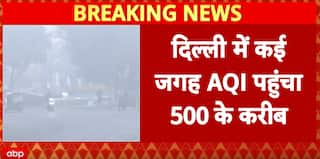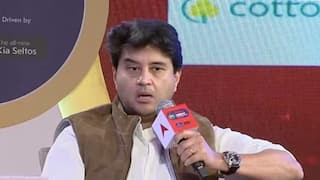Explorer
Ahead Of The SC Hearing On Air Pollution In Delhi-NCR, President Gives Green Signal To Set Up New Commission
President Ram Nath Kovind has signed an ordinance or executive order for the formation of a committee to look into the air quality management in Delhi and its adjoining areas.

Visibility at India Gate(Delhi) on October 29th. Image: ANI
New Delhi: While the national capital is dealing with the rising air pollution problem which has been rising to hazardous levels every year in the festive season, stubble burning has been held responsible for the cause of Delhi's smog. Also Read|Only 'Green' Firecrackers To Manufactured, Sold & Purchased This Diwali: Delhi Govt Though the political leaders are still debating on what is the major cause of the poor AQI levels, President Ram Nath Kovind on Wednesday signed an ordinance to set up a commission for monitoring the air quality in Delhi and its neighbouring states. The ordinance comes a day before the Supreme Court’s hearing on air pollution.
How will the committee function?
According to a government notification, this commission for air quality management will replace the EPCA (environment pollution and prevention control authority) which was formed by the Supreme Court as the apex monitoring body in matters of pollution in the country. It said that a commission will be constituted for air quality management in Delhi-NCR and adjoining areas for better coordination, research, identification, and resolution of problems surrounding the air quality index. It will replace the EPCA which was formed by the Supreme Court as the apex monitoring body in matters of pollution in the country. This commission will also replace all other committees in order to streamline public participation, interstate cooperation in managing air pollution in NCR, and adjoining areas, a gazette notification said. The 17-member-commission will be headed by a chairperson appointed by the Centre. It will include representatives from Delhi, Haryana, Uttar Pradesh, Punjab, and Rajasthan. The commission will be chaired by a government official of the rank of Secretary or Chief Secretary and will include the Secretary Ministry of Environment, Forests and Climate Change and five other Secretary/Chief Secretary level officials as ex-officio members. Worsening Air quality in Delhi and neighbouring states The air quality of Delhi-NCR typically deteriorates in the winter. Earlier this month, the Environment Pollution (Prevention and Control) Authority had asked the Uttar Pradesh and Haryana governments to be ready to shut down thermal power plants that do not meet requirements laid down in 2015. Delhi Chief Minister Arvind Kejriwal had urged Union Environment Minister Prakash Javadekar to hold monthly meetings on pollution with the chief ministers of Delhi, Uttar Pradesh, Haryana, and Punjab. In October, Delhi Pollution Control Committee had banned the use of electricity generator sets of all capacities – whether running on diesel, petrol, or kerosene – in order to curb the pollution. The committee had also declared the whole of the Union Territory of Delhi as an Air Pollution Control Area. In November last year, the top court had passed a slew of directions to check air pollution. The court had asked Punjab, Haryana, and Uttar Pradesh to formulate a plan to purchase stubble, ensure it is not burnt anymore, and make the entire state administration responsible to combat air pollution. It had also ordered the states to pay small and marginal farmers an incentive of Rs 100 per quintal to handle the residue of non-Basmati rice crops. Is stubble burning the major contributor to the rising Air Pollution? Heated spat between the politicians can be seen every year debating on whether stubble burning is the real cause of the rising air pollution. In Punjab, where most of the stubble burning has taken place, the air quality is "moderate". In Delhi, it oscillates between "very poor" and "severe". In fact, the contribution of stubble burning to Delhi's pollution was only 16 per cent on Monday, according to monitoring agency SAFAR. In further fact, a study published by the Council on Energy, Environment And Water (CEEW ) in March last year listed exhaust and emissions from vehicles as the largest contributor of PM2.5 pollutants in Delhi - between 18 and 40 per cent. Dust from roads, the study added, contributed around 36 to 66 per cent of PM10 pollutants. Other sources, like a waste-to-energy plant near a landfill in East Delhi's Ghazipur, add to pollution levels through emissions that can lead to reduced fertility, growth defects, and cancer. Follow Breaking News on ABP Live for more latest stories and trending topics. Watch breaking news and top headlines online on ABP News LIVE TV
Read more






































